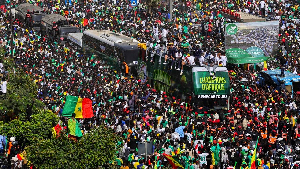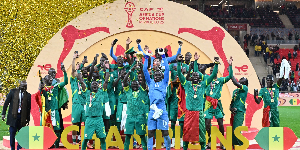“Well, what we know is not what they tell us; we’re not ignorant, I meant it…We refuse to be what you wanted us to be. We are what we are. That’s the way it’s going to be, if you don’t know. You can’t educate I…” (Bob Marley, “Babylon System”).
Among some of the autobiographical details we have so far revealed about Dr. Ama Mazama includes the fact she is a well-respected student, well-rounded researcher, as well as a distinguished professor of comparative (African) linguistics (continental and diasporic), religion, politics, literature, history, and cultural criticism, among others. Also, like Asante, Maulana, Diop, or Obenga, she is grounded in political economy. In addition, her intellectual rootedness in political economy and depth of appreciation of the African world put her squarely in the creative empire of activist scholarship and of intellectual prolificacy, making her one of the most formidable and leading theoreticians of Afrocentricity in Western academia, particularly in the American academy.
Afrocentric theory is not merely a theory dealing with history, epistemology, language, economics, culture, politics, and the like. And as we have eloquently and consistently shown, it’s a creative embodiment of a constellation of progressive ideas, of social and political activism, with a particular focus on the African world in which she prioritizes her interests above others. Namely, Afrocentricity represents the body and soul of Africa’s cultural psychology and humanity. Yet again, it’s a concept with heavy intellectual and research investment in theory and praxis. We may even push the analytic button further and say on authority that praxis probably represents one of the transformative instruments which distinguishes one society from the other. That is, relatively successful societies from relatively unsuccessful ones, or, more qualitatively, one thinker from the other.
Technically, we are arguing that analytic verbiage or fustian posturing, a methodological style devoid of activist and intellectual substance, is not a character trait of the process of Afrocentric theorizing. Importantly, one of Mazama’s and Asante’s remarkable contributions to knowledge production on the African world appears in the form of their edited volume “The Encyclopedia of African Religion.” The Library Journal says of the Encyclopedia: “Numerous titles focusing on particular beliefs in Africa exist, including Marcel Griaule’s conversation with Ogotemmeli, but this one presents an unparalleled exploration of a multiple of cultures and experiences. It’s both a gateway to deeper and a penetrating resource on its own. This is bound to become the definitive scholarly resource on African Religions.” Indeed this is a landmark contribution to cultural scholarship on the African world!
In fact, the Encyclopedia beats every single academic work on African Religion before or after by its unparalleled breadth and sheer weight of cultural, historical, epistemological, and cosmogonic analyses. However, its overriding achievement is seen in its epistemological success when Afrocentricity jilts Eurocentric interpretation of African culture at the altar of cultural fairness. On the other hand, Kwame Anthony Appiah has taken issue with Marcel Griaule’s methodological dialogue with Ogotemmeli, a respected and knowledgeable storehouse of Dogon Religion (See Griaule’s “Conversations with Ogotemmeli” and “The Pale Fox”). On another philosophical plane, we have not yet fathomed a suitable justification for Appiah’s overweening orientation, whether he actually sees himself a better anthropologist or ethnologist than the acclaimed and meticulous Marcel Griaule and his student Germaine Dieterlen, whether he actually thinks he knows more than Ogotemmeli, or whether he has philosophical problems with Griaule’s and Germaine’s methodological approach.
But that is beside the point. Let’s attempt an evaluation of the influence of the Encyclopedia from another critical angle. Still, before we do so, let’s remind ourselves as we have consistently and controversially argued elsewhere, that our newly-proposed educational institutions, to wit, Afrocentric education, need to explore the question of spirituality, African spirituality, in the main, as part of the new pedagogy of moral conscientization. Admittedly, this must, however, be done within a larger contextual framework of religious tolerance. Again, this is why Asante’s and Mazama’s edited volume “The Encyclopedia of African Religion” is such a significant work. This creative work also ushers in the academization of African Religion as a formidable area of academic research and study in the fields of cultural studies, moral philosophy, and comparative religion.
Meanwhile, elements of the Egyptian “Book of the Dead,” properly called “Book of Coming Forth by Day,” Maulana Karenga’s “Maat, The Moral Ideal in Ancient Egypt: A Study in Classical African Ethics,” as well as other issues raised by him through “Odu Ifa: The Ethical Teachings,” Afolabi Epega’s “The Sacred Ifa Oracle,” etc., and several important religious ideas from ancient Africa made it to the Encyclopedia. The African roots of Judaism, Christianity, and Islam as well as the cultural spread of African religion outside Africa to the Western Hemisphere see the light of day in the Encyclopedia. It’s proper at this juncture to revisit one of the monumental episodes in the history of human civilization, when Molefi Kete Asante reminded participants at the “Decolonizing Our Universities” international conference, held in 2011, Malaysia, and attended by researchers, scientists, policy makers, authors, academics, and educators from around the world, that Asia, very much like the West, looked down upon African Religion.
Apparently, Asante’s indicting rhetoric had come against the backdrop of Asia’s flagrant exclusion of African Religion from brochures advertizing world’s religions, as he toured a few places in Asia. We should add that this Asian intellectual contradiction shares an ironic confluence with Western abnegation of Hindu as a religion at the height of colonialism. “The Nineteenth century was the era of European imperialism,” writes David Frawley, adding: “Many Europeans did in fact believe that they belonged to a superior race and that their religion, Christianity, was a superior religion and all other religions were barbaric, particularly a religion like Hinduism which uses many idols (See “The Aryan-Dravidian Controversy”). Yes, the polytheistic pigmentation of Hinduism compelled Europe to discard it as a religion in the classic Eurocentric sense of religion. Alternatively, many European scholars did not consider Confucianism, Buddhism, and Taoism religions either, believing that Buddhism lacked a centralized deity as the Yahweh and Christ of Judaism and Christianity, respectively.
Now it is not the West which is renouncing African Religion as a religion. Africans are doing exactly that on the West’s behalf. African movies, particularly Nigerian and Ghanaian ones, elevate Christianity above African Religion, though the Chinese and Indians don’t use their movie industries to promote Christianity above Buddhism, Taoism, Confucianism, and Hinduism. Could Asian cultural independence have been the source of their miraculous rise in world affairs? Possibly. After all, they don’t copy blindly as Africans do. But the issues are more complicated than they seem at face value. Where exactly does Africa feature in these civilizational innovations? These conscious flows of stony ironies had once been observed by the late Ivan Van Sertima, an ex-literary advisor to the Nobel Committee, who made a pointed assertion by giving away the fact that Western epistemology and historiography consistently wrote the Arab (Islamic) world out of classical history even as the Arab (Islamic) world consistently wrote the African world out of classical history.
In other words, both the West and the Arab world accorded the black man a status of civilizational, cultural, and intellectual inferiority. Yet, none of them, either the Arab world or the West, appreciates the historicity of Christological, Muhammadological, or Judaicized monotheism as an African invention, a cultural creation attributed to Pharaoh Akheneten. Indeed, African religion is as rigidly monotheistic as Judaism, Christianity, or Islam is loosely monotheistic. Again, history credits the Egyptian Akheneten, an African king who ruled over an advanced and civilized ancient state, with originating the concept of monotheism. Even Sigmund Freud, the father of psychoanalysis, himself a Jew, believed Moses and monotheism were autochthonously Egyptian. Conceptually, though, African Religion may come across if not as deceptively then as confusedly henotheism to the untrained eye and cultural psychology of the West. Then again, this prepossessing acknowledgment is bound to trap even a prostituted mentality, be it African, Asian, or Western.
In fact, Asians did not care if the West labeled any of their religions polytheistic. They never cared because they vehemently refused to be defined by the emotional narrowness of some else’s cultural singularity, that of the cracked mirror of Western standards, Eurocentrism, that is. To a certain extent, Asians are comfortable in their own glorified center of unified self-definition, while, on the other hand, the inhumation of Africans assumes clueless numerosity of psychocultural centers in a way that defies the cultural logic of unitary centeredness. More importantly, the academized resuscitation of African Religion, courtesy of Mazama and Asante, is as formidable a task as it is psychologically-draining, herculean and daunting. On another level, this intellectual enterprise of upraising African Religion after centuries of Western conscious effort to suppress it takes on an investigational identicalness to Wole Soyinaka’s sleuthing schemes to retrieve African artifacts, treasured and creative legacies of ancient Africa, stolen by the West and shamelessly put on public display in Western museums. Soyinka wants them repatriated to Africa.
One such incident took place when he, that is, Soyinka, held a prestigious professorship at Yale University, along with Kwame Anthony Appiah and Henry Louis Gates, Jr., his former Cambridge University students. Soyinka got wind of a well-placed piece of information confirming a sighting of one of the treasured Benin Bronzes stashed in a hideout in as far away a place as Brazil. It turned out that he, Gates, and others from the same department wanted those artistic items for a commemorative convocation appreciating African ingenuity. Soon, he embarked on a long journey of discovery to Brazil, only to realize that the original Benin Bronze had been salted away in an undisclosed location, Indiana-Jones-and-the-Temple-of-Doom-like, while the one he held closely in his hands was merely a clayish replica of the original. He left the fake artwork back in Brazil and went back to America. Then another piece of news involving a sighting of another Benin Bronze in a British museum arrived on the doormat of his eardrum. He went to Britain right away, visiting the said museum.
Moreover, there, unlike in Brazil, he found an original Benin Bronze caged in a glassy compartment. Again, exactly as in Brazil, he contemplated secreting it away. That was not possible on the first day, however. So, he began nursing a storied scheme to court the friendship of one of the museum’s African employees, possibly a Sierra Leonean or Liberian, to help him “steal” the artifact and return it to Africa by way of Yale University. Little did he know he was being closely watched and monitored! Unfortunately, on the very day when he decided to actualize his hatched plans the Benin Bronze had mysteriously disappeared before he had known it, once again, only to be replaced by another fake replica. Sadly, Soyinka, again, returned to America intellectually unfulfilled. Questions: How come you cannot get back what rightfully belongs to you? In other words, how come the Africa world cannot get back what rightfully belongs to her? The fact is that Soyinka’s physical journey has a spiritual component to it as well.
That is to say, how does the African world, symbolized by Soyinka, get back her dignity and cultural psychology, symbolized by the stolen artistic items, after centuries of Eurocentric poisoning, symbolized by slavery, colonialism, and neocolonialism? Indeed his dilemma is reminiscent of the crushing weight of psychoemotional migraine which many of our scholars, the likes of Asante, Sertima, Fanon, Mazama, Du Bois, Awoonor, Nkrumah, Diop, Obenga, Maulana, Armah, Thiong’o, to name a few, carry daily in the corridors of academia trying to mend Africa’s fractured psychocultural identity. Indeed Eurocentrism is a bigger oncological ocean than we thought! Further, these recounted Soyinkan events are closely similar to the screenplay for producer Lancelot Oduwa Imasuen’s epic movie, “Nogbaisi Ovonramwen,” which was set to begin shooting in 2013.
This epic film deals with the late-19th-Century British invasion of the Benin Empire during the reign of the last Oba, otherwise referred to as Oba Nogbaisi Ovonramwen. Imasuen made the following remarks in a 2012 interview: “We’ve been able to dig into history and I want to use the production as a major channel to advocate the repatriation of the artifacts stolen from the Benin Kingdom by the British expedition.” Elsewhere it has been reported that “the film will be used to champion the cause of drawing global attention to the injustice meted to the ancient people of Benin many centuries ago” (See “Producer Lancelot Set To Rewrite Benin History”). Yet again, this story is shamefully and familiarly analogous to the controversy surrounding “the Kohinoor,” a 106-carat Indian diamond stolen by the British and subsequently included in the British Crown Jewels some 150 years ago (See Satish Jacob’s “Indian MPs Demand Kohinoor’s Return.”
Let’s set the Indian case aside and concentrate on our own African situation. Clearly, these bold Afrocentric attempts at collective self-recovery, that is, of African Renaissance, a theoretical analysis we eloquently advanced in “Ama Mazama: An Intellectual Warrior (ll),” demand a repatriation of the African “self.” The African “self” is a collectivity of elements composed of human psychology, principally artefactual, spiritual, historical, psychological, literary, scientific, and cultural, as they relate to the African world. Among other things, the repatriation of the African “self” entails resuscitative academization of African Religion, psychological and cultural de-centering of African humanity, complete dismantling of the ideological scaffolding of black racial inferiority complex and of uncritical idolization of white cultural symbols, revival of African spirituality, total freedom from foreign control, etc. These constitute the noble objectives of Afrocentricity International.
Let’s recall them here: “To persistently and aggressively identify proper sources of African knowledge pertaining to cultural, economic, and social phenomena. To analyze and critique domination of people, classes, gender, ethnicities, in all circles and to rescue language, symbols, historical documents and monuments in the name of a renascent people.” Admittedly, these two formulaic ideas capsulize all the major arguments, concepts undergirding the moral philosophy of Afrocentricity International, we have advanced thus far. Please go back again for a re-perusal! Read them again! Now, regarding the tireless efforts instituted by dedicated Afrocentrists to link theory and praxis together in the intellectual elevation of the African world to the height of Mount Kilimanjaro where the problem-solving aptitude of Africa perches, Asante and Mazama share two more objectives of Afrocentricity International with us: “To constantly create and vigorously disseminate ideas that center people of African descent in their own historical experiences as a way of converting problems into solutions. To influence all African public policy in every continent and every country in order to accelerate the rise of Afrocentric consciousness, the hallmark of a new African renaissance.”
However, pertaining to how the West generally views African Religion, let’s recall what the “USA Today” had to say of Pope John Paul ll’s 1993 visit to Benin: “Chanting young girls treated Pope John Paul ll to a ‘trance-inducing’ voodoo dance at an unusual encounter between the leader of the world’s Roman Catholics and Benin’s top voodoo doctors. The Pope told voodoo followers in the west African country, birthplace of the traditional religion, that they would not be betraying their ancestors if they became Roman Catholics (See John Kenneth Weiskittel’s “Voodoo You Trust: John Paul ll’s Betrayal In Benin”).” These are the questions for us to answer: Why are “Roman Catholics,” Pope, and Pope John Paul ll capitalized while “voodoo doctors,” “voodoo followers,” and “west,” as in “west African,” uncapitalized? What does “unusual encounter” mean in this context? Was the concept “unusual” evaluated from Western or African perspective? Wasn’t Pope John Paul ll’s official visit to Benin communicated to Benin before he and his entourage embarked on that journey? If so, couldn’t the so-called trance-inducing “dance” have been part of the ceremonious reception?
Was this the first time Pope John Paul ll saw a group of human beings dancing firsthand? What is “voodoo doctors”? What did Pope John Pope ll know about “betrayal” and ancestral relationship with the living in an African context? Why didn’t Pope John Paul ll use the opportunity to apologize to the African world for the Catholic Church’s ignominious role in the European enslavement of Africans, a moral gesture akin to the simultaneity of the Catholic Church’s publicly acknowledging the historical wrongs it leveled against European Jews and publicly rendering a formal apology to them? Let’s rephrase the last sentence in the “USA Today” article: “The Pope told catholic followers in the west European country, birthplace of the traditional catholic religion, that they would not be betraying their saints if they became Voodoo Votaries!” How does it look like? Isn’t this so-called “trance-inducing” voodoo dance a regular feature of praise and worship in modern Christianity, particularly Pentecostal and Charismatic churches?
This bare hypocrisy deriving from an epistemological question of historical, political, and cultural antipodality between Western Christianity and African culture, in the main, constitutes the causation of African Initiated Church (AIC). South Africa’s Shembe Church, Kenya’s Akorino Church, Eritrean/Ethiopian Orthodox Tewahedo Churches, Nigeria’s Open Door Life Assembly, etc., are good examples. But culturally-centered Africans will not allow the ghostly ignorance of the West to pass uncritiqued: “The priests were at pains to say that there was nothing ungodly about a faith that recognizes a ‘master creator’ of the universe beyond all lesser gods. ‘The master of life knows that vodun has nothing to do with Satan or the devil,’ Mr. Zannou…said. ‘It is God that is the final object of vodun worship,’” writes Alan Cowell, author of “Vicar of Christ,” an unabashed defense of Voodoo. Again, the internationalist project, symbolized by “The Encyclopedia of African Religion,” was so significant as to draw the auctorial attention of two distinguished US-based Ghanaian scholars, Dr. Kwame Akonor, Director of the Center for Africana Studies as well as of the New York-based African Development Institute, and Dr. Kofi Asare Opoku.
Finally, as with all their scholarly works, Mazama and Asante always have in mind the unifying power of Afrocentric wisdom, a moral trademark of their research activities and intellection. Similarly, Bob Marley’s “Top Ranking” comes in mind. He sings: “They don’t want to see us unite. All they want us to do is keep on fussing and fighting. They don’t want to see us live together. All they want us to do is keep on killing one another…Brotherly love, sisterly love.” What does this say about Afrocentricity? “Unity” is what the title “The Encyclopedia of African Religion” stands for. How so? Part of the title says “African Religion,” not “African Religions”! Watch out! The orthographic pluralization of “religion” would have made a huge difference. Let Judaism, Christianity, and Islam, the three so-called Western Religions, taking note of the orthographic pluralization, “Religions,” belong to the cultural divisiveness of Eurocentrism.
Let African Religion, taking note of the orthographic singularization, bring us together in a unitary collectivization of cultural oneness for the growth and development of the continent.
We shall return…
Opinions of Saturday, 15 February 2014
Columnist: Kwarteng, Francis














